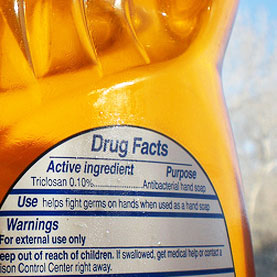In 1978 the Bee Gees ruled the airwaves, Grease topped the box office and the U.S. Food and Drug Administration first proposed a rule on antibacterial hand soaps—a rule that would have eliminated an unnecessary and unsafe ingredient called triclosan. Thirty-five years later many things have changed, but the FDA has not. Just recently it proposed rules on antibacterial soaps that would remove triclosan-containing soap from the shelves—for the third time. Yet because the FDA has failed to finalize any of these proposals, triclosan has proliferated in the marketplace. It is now the most common active ingredient found in antibacterial consumer hand soaps.
It’s also common in our bodies. Triclosan has been measured in amniotic fluid, breast milk, human blood and the urine of 75 percent of Americans sampled over the age of six. Although it does not discriminate by gender or racial/ethnic group, it appears to increase in concentration as income increases. Despite little evidence of their effectiveness to reduce illness, triclosan-containing antibacterial soaps have dominated the market. Soap aside, triclosan can also be found in consumer products as diverse as cutting boards, shoes, lipstick and toothpaste.
In other words, we are continually exposed to triclosan. The problem is that triclosan is not safe. In animal studies it has been shown to interfere with the regulation of thyroid hormones (affecting metabolism and brain development), testosterone synthesis (decreasing sperm counts) and estrogen action (causing early onset of puberty). Exposure to triclosan has been shown to weaken heart muscle, impairing contractions and reducing heart function, and to weaken skeletal muscle, reducing grip strength. In aquatic environments fish exposed to triclosan were unable to swim properly.
Higher urinary levels of triclosan are associated with hay fever, allergies to airborne triggers (like ragweed and cats) and food (peanut, shrimp, dairy) allergies. Triclosan has even been associated with elevated body mass index in adults. Although the mechanism driving this association is not clear, researchers suggest that it could be due to changes in the gut flora or hormones.
There are also concerns about the potential impact of triclosan use on development of antibiotic resistance. Laboratory studies on bacteria exposed to triclosan demonstrate evidence of cross-resistance to critically important antibiotics including erythromycin, ciprofloxacin, ampicillin and gentamicin. Further, there is evidence that resistance to triclosan itself exists in Salmonella enterica, Staphylococcus aureus, streptococcus, Escherichia coli and other species of bacteria. Strains of Mycobacterium tuberculosis tolerant to triclosan have also showed resistance to the drug isoniazid (INH), which is used to treat tuberculosis. Although the overuse of antibiotics in humans and livestock is a greater contributor to the public health crisis of antibiotic-resistant bacteria, the potential increased risk of antibiotic resistance from the use of antimicrobial chemicals is unnecessary.
To add insult to injury, there is no added benefit to using triclosan (or any antibacterial) soaps. Triclosan is intrinsically ineffective against some bacteria like Pseudomonas aeruginosa and fungal infections. The FDA requires that to be considered effective these soaps must do more than remove bacteria; they must “provide a clinical benefit by reducing infections.” But studies show that using soap containing triclosan does not reduce human illnesses or infections any more than using regular soap. There have even been occasional reports of fatal bacterial outbreaks in hospitals using triclosan, including bacterial contamination of triclosan soap containers in a surgical intensive care unit.
Which brings us back to the FDA. In the rule it proposed in 1978 (and again in 1994 and 2013) the FDA said it does not have sufficient information to determine whether triclosan is safe or effective. In the absence of such a determination triclosan cannot be sold in the U.S.—but the FDA’s failure to finalize these proposals allowed the products to remain on the market. Therefore, in 2010 the Natural Resources Defense Council sued the FDA to compel it to finalize its rules. As a result of the settlement, the FDA now has to finish its rules on antibacterial soaps by September 2016. If at that time the FDA still cannot say triclosan is safe and effective, then antibacterial hand soaps can no longer contain triclosan. Until then, antibacterial soaps remain on the market and consumers are left to protect themselves from this harmful chemical.
Source: Scientific American

